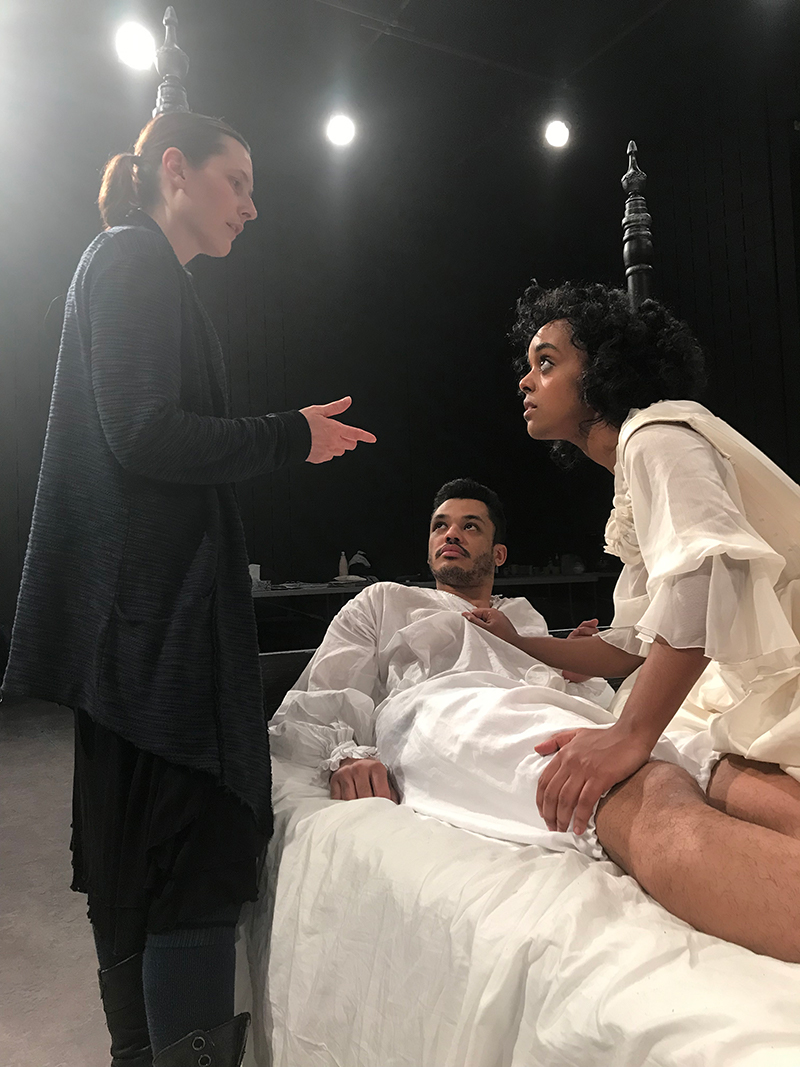
Intimacy Director, Janine Waddell (left), coaching BFA Acting students Diego Stredel and Helen Belay through a scene from Studio Theatre's "All for Love" by John Dryden.
Janine Waddell is credited as both the Fight Director and Intimacy Director for All for Love, the Studio Theatre production that opens February 7, 2019, at the Timms Centre for the Arts.
While Fight Directing has been part of theatre for a long time, the role of Intimacy Director is relatively new, with more theatre companies slowly beginning to adopt the role into their rehearsal process.
A director and certified movement instructor since 1991, we caught up with Janine to learn more about how the role of Intimacy Director helps actors approach scenes of intimacy safely and comfortably, while maintaining artistic integrity.
ARTS NEWS: What is an Intimacy Director?
JANINE WADDELL: Given that the title/role is fairly new within the industry, the definition is still being sussed out by those of us who have been practicing the art without a name. That includes those colleagues of mine who are doing the hard work of breaking ground with marketing and the standardization of the concept itself.
The most obvious answer is that the Intimacy Director (or Intimacy Choreographer) is the artist who choreographs the scenes in which intimate touch occurs. This is true, however, there is a lot that must happen in order to do that job respectfully and safely. We facilitate the sharing of vocabulary that ensures informed consent is given by the performers, while guiding the exploration of movement and storytelling throughout the rehearsal process.
AN: Why is an Intimacy Director necessary in this staging of All for Love? How prominent is this role becoming in the theatre community?
JW: This year's staging of All For Love at the University of Alberta had some moments of a significantly suggestive nature. The University and the director, Peter Hinton, decided early on that an Intimacy Director would bring some essential tools to the rehearsal hall. From my experience, this institution has been incredibly supportive of its students' well-being and, I believe, is showing once again its willingness to be at the forefront of a movement towards safer working environments for all theatre artists.
The role of the Intimacy Director has become a real talking point as of late. I find myself suddenly being contacted by theatres across the country and by producers and directors who want to discover what methodologies are part of my practice. The most exciting aspect of this national and international interest in the work for me has been a chance to connect with colleagues I never even knew I had, and moreover, to feel like I am part of a community of choreographers. I have spent the majority of my career simply trying to create a dialogue about consent. This formalization of the concepts of this practice is an encouraging sign that Intimacy Choreographers will be taking a significant position in both theatre and film.
AN: What are some of the ways you help actors and directors approach a scene that may involve heightened physical touch / intimate contact?
JW: We start the process with a workshop, leading the cast, director and other team members through a conversation that introduces vocabulary and exercises specific to connection and consent. This grounds the work in a place of aware, mutual respect and open communication. We then confirm which areas of the body the artists are willing to offer for choreography and also what they are comfortable touching on the other person.
Once we have that framework in place, the choreography is developed as if it was a dance, or as many of us call it, pure movement. The actors learn the staging of the scenes without reference to the emotional context first. This may sound odd, but in my experience, it has been an essential step.
The clinical nature of the approach reminds everyone that this is storytelling and there are multiple checkpoints in the operation to confirm that everyone is still feeling safe and heard.
AN: How does one become an Intimacy Director?
JW: My journey to this career has been a long and winding one, first as a dancer and dance instructor, then through directing and fight direction. There are some organizations now offering Intimacy Direction training; that's probably a great place to begin. That wasn't an option until very recently. Mental Health First Aid, research in psychology, talking to qualified sex and gender educators and any kind of movement training is hugely beneficial.
COMING UP: BFA Acting students and All for Love performers, Melanie Bahniuk and Chris Pereira, give the actor perspective on the importance of an Intimacy Director.
 About Janine Waddell
About Janine Waddell
A director and certified movement instructor since 1991, Janine Waddell has drawn from her experience in both dance and theatre to develop her stage combat curriculum. She has travelled extensively for her training in theatrical unarmed and weapon based violence, going wherever the best Fight Masters are based. She is currently an internationally certified Advanced Actor Combatant with FDC and SAFDi and a certified Actor Combatant with SAFDi, BASSC and NSF.
Janine is an active member of the Edmonton Theatre Community and its budding Film Industry, having choreographed the violence and intimacy for over 50 plays and films in the past five years. Her passion lies in teaching new talent; putting swords in the hands of young people all over Alberta. Janine graduated from the Grant MacEwan Theatre Arts program and is a proud mother of four.

All for Love
By John Dryden
February 7 - 16, 2019
(No Show February 10, Matinee February 14 at 12:30 PM)
Timms Centre for the Arts
Tickets & Production Info